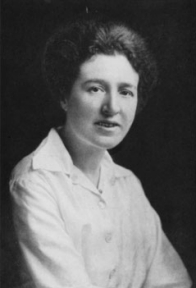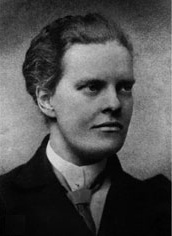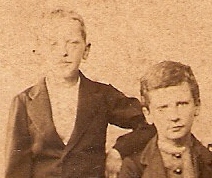Mary Stuart MacDougall | |
|---|---|
 | |
| Born | 1885 [1] |
| Nationality | American |
| Occupation | Biologist |
Mary Stuart MacDougall (born 1885) was an American biologist who studied protozoology. She wrote Biology: The Science of Life.
Mary Stuart MacDougall | |
|---|---|
 | |
| Born | 1885 [1] |
| Nationality | American |
| Occupation | Biologist |
Mary Stuart MacDougall (born 1885) was an American biologist who studied protozoology. She wrote Biology: The Science of Life.
MacDougall received her Bachelor of Arts from Randolph–Macon College in 1912 before proceeding to get her Master of Science from the University of Chicago and finally, her Ph.D. from Columbia University, in 1925. [1] In 1920, MacDougall would become the head of the biology department at Agnes Scott College. She worked at Agnes Scott until 1952, when she retired. [2] Every summer, for fourteen years, MacDougall was an instructor and researcher at the Marine Biological Laboratory. [1]
While at Agnes Scott, MacDougall studied protozoology and cytology. [1] She studied the polyploid and diploid of chilodonella uncinata , as well as mutation inheritances found in them. MacDougall also researched the chromosomes of plasmodium, avian malaria and neuromotors of chlamydodon. [2]

Barbara McClintock was an American scientist and cytogeneticist who was awarded the 1983 Nobel Prize in Physiology or Medicine. McClintock received her PhD in botany from Cornell University in 1927. There she started her career as the leader in the development of maize cytogenetics, the focus of her research for the rest of her life. From the late 1920s, McClintock studied chromosomes and how they change during reproduction in maize. She developed the technique for visualizing maize chromosomes and used microscopic analysis to demonstrate many fundamental genetic ideas. One of those ideas was the notion of genetic recombination by crossing-over during meiosis—a mechanism by which chromosomes exchange information. She produced the first genetic map for maize, linking regions of the chromosome to physical traits. She demonstrated the role of the telomere and centromere, regions of the chromosome that are important in the conservation of genetic information. She was recognized as among the best in the field, awarded prestigious fellowships, and elected a member of the National Academy of Sciences in 1944.

In biology, a biological life cycle is a series of changes in form that an organism undergoes, returning to the starting state. "The concept is closely related to those of the life history, development and ontogeny, but differs from them in stressing renewal." Transitions of form may involve growth, asexual reproduction, or sexual reproduction.

Mary Frances Lyon was an English geneticist best known for her discovery of X-chromosome inactivation, an important biological phenomenon.

Frank Rattray Lillie was an American zoologist and an early pioneer of the study of embryology. Born in Toronto, Ontario, Canada, Lillie moved to the United States in 1891 to study for a summer at the Marine Biological Laboratory (MBL) in Woods Hole, Massachusetts. Lillie formed a lifelong association with the laboratory, eventually rising to become its director in 1908. His efforts developed the MBL into a full-time institution.

Marion Lorne MacDougal or MacDougall, known professionally as Marion Lorne, was an American actress of stage, film, and television. After a career in theatre in New York and London, Lorne made her first film in 1951, and for the remainder of her life played small roles in films and television. Her recurring role as Aunt Clara in the comedy series Bewitched, between 1964 and her death in 1968, brought her widespread recognition, and she was posthumously awarded an Emmy Award for Outstanding Supporting Actress in a Comedy Series.

Gertrude Mary Cox was an American statistician and founder of the department of Experimental Statistics at North Carolina State University. She was later appointed director of both the Institute of Statistics of the Consolidated University of North Carolina and the Statistics Research Division of North Carolina State University. Her most important and influential research dealt with experimental design; In 1950 she published the book Experimental Designs, on the subject with W. G. Cochran, which became the major reference work on the design of experiments for statisticians for years afterwards. In 1949 Cox became the first woman elected into the International Statistical Institute and in 1956 was President of the American Statistical Association.

Mary Agnes Hamilton was a writer, journalist, broadcaster, civil servant, and the Labour Member of Parliament for Blackburn from 1929 to 1931.

Plant anatomy or phytotomy is the general term for the study of the internal structure of plants. Originally it included plant morphology, the description of the physical form and external structure of plants, but since the mid-20th century plant anatomy has been considered a separate field referring only to internal plant structure. Plant anatomy is now frequently investigated at the cellular level, and often involves the sectioning of tissues and microscopy.
Wilfred Eade Agar FRS was an Anglo-Australian zoologist.

Agnes Robertson Arber FRS was a British plant morphologist and anatomist, historian of botany and philosopher of biology. She was born in London but lived most of her life in Cambridge, including the last 51 years of her life. She was the first woman botanist to be elected as a Fellow of the Royal Society and the third woman overall. She was the first woman to receive the Gold Medal of the Linnean Society of London for her contributions to botanical science.

Ethel Sargant was a British botanist who studied both the cytology and morphology of plants. She was one of the first female members of the Linnean Society and the first female in their council, as well as President of the Federation of University Women.

Johannes Reinke was a German botanist and philosopher who was a native of Ziethen, Lauenburg. He is remembered for his research of benthic marine algae.

Michał Marian Siedlecki was a Polish zoologist.

Helen Redfield, was an American geneticist. Redfield graduated from Rice University in 1920, followed by earning her Ph.D. in zoology from the University of California, Berkeley in 1921. While at Rice, she worked in the mathematics department. She joined the faculty of Stanford University in 1925 and that same year she became a National Research Fellow at Columbia University. In 1926 she married Jack Schultz, the couple would have two children. Redfield retained her maiden name upon her marriage. In 1929 she worked as a teaching fellow at New York University. Ten years later she worked as a geneticist in the Kirchoff Laboratory at the California Institute of Technology. Starting in 1942, during World War II, she worked as a lab scientist at Cold Spring Harbor Laboratory during the summer. From 1951 until 1961 she served as a research associate at the Institute for Cancer Research.

Agnes Mary Claypole Moody was an American zoologist and professor of natural science.
Sally Hughes-Schrader (1895–1984) was a professor of zoology at Duke University, 1962-1966.
Mathilde Simone Rachel Pauline Bensaude was an internationally renowned mycologist and plant pathologist whose pioneering doctoral thesis at the Sorbonne first showed heterothallism in the Basidiomycetes. Bensaúde is also a major pioneer in the field of Plant Pathology in Portugal, and founded Portugal's Plant Quarantine Services and is one of the founders of the Portugal Society of Biology.
Mary-Lou Pardue is an American geneticist who is an emeritus professor in the Department of Biology at the Massachusetts Institute of Technology, which she originally joined in 1972. Her research focused on the role of telomeres in chromosome replication, particularly in Drosophila.

Helen MacKellar was an American actress.